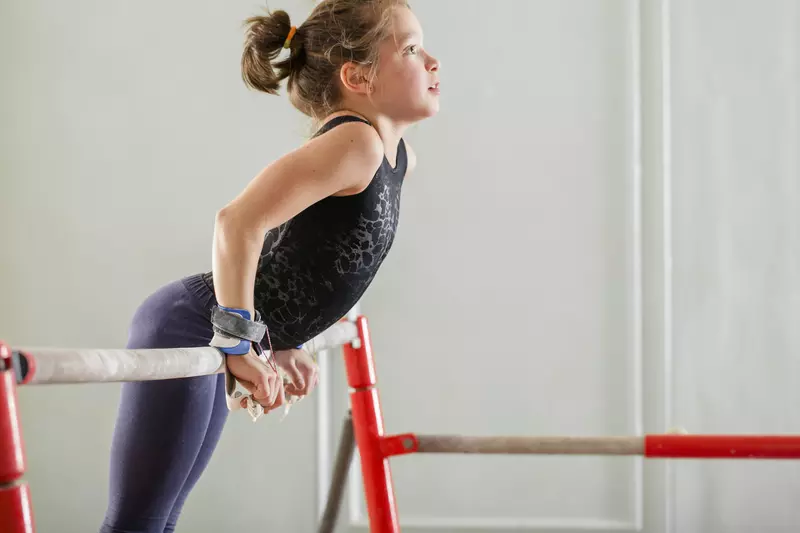- AdventHealth

The devastating injury that apparently ended the athletic career of a college gymnast has refocused attention on how children and young adults can enjoy their sports while staying safe.
Auburn University gymnast Samantha Cerio dislocated both of her knees and tore multiple ligaments as she landed a jump during an April 5 competition. In an Instagram post afterward, Cerio said she was proud of how the sport had made her a better person but that she had seen her last day as gymnast.
Michelle M. Ramirez, PT, DPT, OCS, orthopedic research manager at AdventHealth Sports Med and Rehab, sees most of her patients after an injury. She believes many of these accidents can be prevented when a young athlete sees a physical therapist as they enter puberty.
“Injury prevention is most important between the ages of about 12 and 16, when kids’ bodies and neuromuscular abilities are still developing,” Ramirez says. Correcting potential problems early can ensure that kids build habits that will serve them for decades to come.
Preventing the Most Common Injuries
It’s easy to assume that most injuries on a soccer field, basketball court or other field of play happen when two players collide, but that’s not the case, Ramirez says.
Studies have found that most young athletes who are hurt sustain non-contact injuries, as Cerio did. Staying safe is therefore about helping athletes build control over their movement.
One major element of injury prevention is to look for potential weak spots in movement — the technical term is “biomechanical deficit” — that could lead to injury.
To see a common example, try this:
Stand on one leg and start a squat. As you move down, you may notice that your weight-bearing knee starts to bend inward. If the knee bends too much, excess stress is placed on the knees during the landing after a jump.
Ramirez says athletes with this condition, sometimes called knock-knees, can benefit from a series of exercises to strengthen their hips, core and thigh.
A physical therapist can also help athletes build techniques to land a jump safely.
Building Your Sixth Sense
Have you ever walked down steps and hit the floor when you had thought there was still another step? It’s jarring, right?
You usually don’t look at the ground when you walk and instead depend on your body to know where you are.
This ability is called “proprioception,” or the sense of where your body is located in space, and it’s sometimes called our “sixth sense.” Making such a mistake while walking down the steps can be surprising, but the consequences can be severe during a high-impact sport.
It’s impossible to know for sure what happened to Cerio, but she was hurt after a “blind landing,” meaning she wasn’t looking at the ground when she landed. This is a normal part of gymnastics and other sports, so it’s an important skill to build.
Mistakes in landing after a jump are a major cause of sports injuries, especially in basketball, volleyball and gymnastics, Ramirez says. But it’s possible to help young athletes improve their proprioception and lower their risk for these injuries.
AdventHealth Sports Med and Rehab has physical therapists, including Ramirez, with experience leading a jump training program that has been shown to reduce ACL injuries in high school athletes. The program is geared toward women and girls, but men and boys can also benefit from it.
Some injury prevention principles are specific to a sport, but others are good practice for all young athletes. Among the most important is to try multiple sports.
Play Multiple Sports
Many injuries, especially among boys and men, come from the overuse of a joint or other body part. A full-time runner may develop shin splints or a pitcher may strain their shoulder.
Trying out multiple sports is one way to build underdeveloped abilities, which can boost performance in every sport. Each sport has a different impact on the body, so playing many of them can minimize long-term stress on any single body part.
Take Pain Seriously
If your child is feeling pain for more than 10 to 14 days, take a break. It could be a sign of a future injury that rest, ice and other basic treatment could prevent. (Check out this AdventHealth parent’s guide to recognizing and treating these injuries.)
However, injuries are still a risk despite the best of precautions.
“At this point, science hasn’t figured out how to prevent 100% of injuries, though we can reduce their risks,” Ramirez says.
Most families decide the benefits of youth sports — the nourishment of their body, lifting of their spirit and strengthening of their friendships — outweigh the risk of injury.
Cerio has months of recovery ahead of her, Ramirez says, but even this serious injury hasn’t weighed down her spirit. She says she has a bright future, including a summer wedding and a job at Boeing as an engineer.
Even just two days after her injury, Cerio was thankful for what gymnastics had given her.
“I couldn’t be prouder of the person that gymnastics has made me to become,” she wrote on Instagram. “It’s taught me hard work, humility, integrity, and dedication, just to name a few.”
It’s a reminder of the value that sports can play, as well as how a healthy mind and spirit can help overcome physical challenges.
AdventHealth Sports Med and Rehab has 19 Central Florida locations, so there’s a convenient choice no matter where you live. For more information, call Call407-303-8080 or visit our website.



